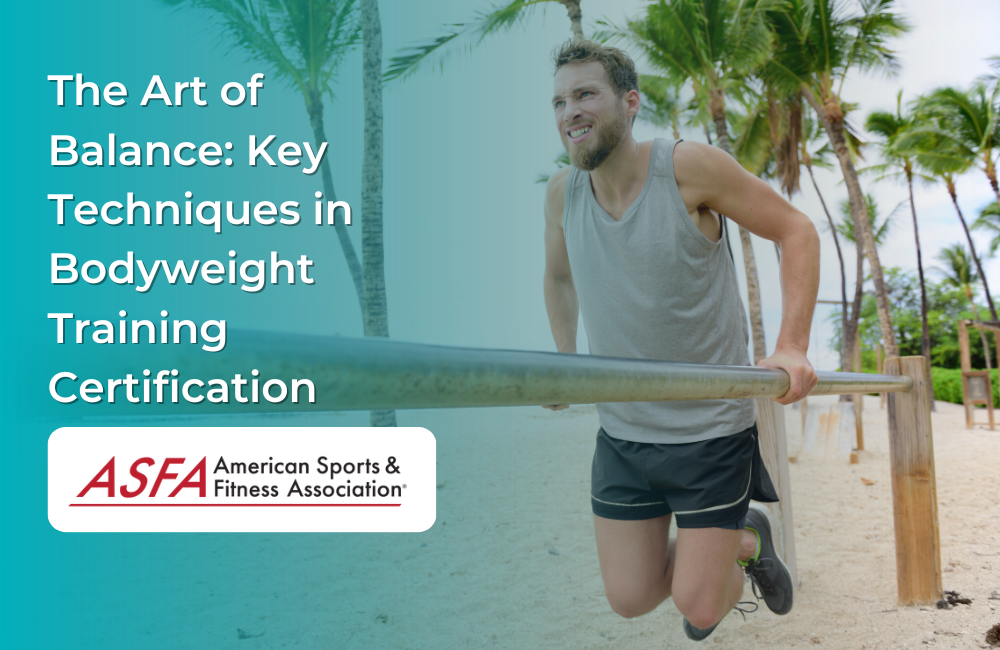Bodyweight training certification is more than just learning exercises; it's about mastering the art of balance, both physically and in your training approach. In this blog, we will explore the essential techniques that bodyweight training certification programs cover, emphasizing the importance of balance in your training journey.
1. Form and Alignment
Maintaining proper form and alignment is crucial in bodyweight training. Certification programs emphasize the following aspects:
- Posture: Learning how to align your body correctly during exercises to minimize the risk of injury and maximize muscle engagement.
- Breathing: Proper breathing techniques that support performance and prevent dizziness or fatigue.
- Progressions and Regressions: Understanding how to adapt exercises to different fitness levels and body types while maintaining good form.
2. Core Strength and Stability
A strong core is the foundation of bodyweight training. Certification programs teach:
- Core Engagement: How to activate and engage the core muscles to improve stability and balance during exercises.
- Variations: Progressing from basic core exercises like planks to more advanced ones like dragon flags.
3. Mobility and Flexibility
Balance extends to your range of motion. Certification programs delve into:
- Dynamic Warm-Ups: Techniques to prepare your body for movement and reduce the risk of injury.
- Stretching and Flexibility: Incorporating stretching routines to improve mobility and flexibility.
4. Skill Development
Bodyweight training is not just about strength; it's about mastering skills. Certification programs cover:
- Skill Progressions: Learning how to break down complex movements like handstands or muscle-ups into manageable progressions.
- Coordination and Timing: Developing the coordination and timing required for advanced bodyweight exercises.
5. Mind-Body Connection
Achieving balance in bodyweight training involves connecting your mind with your body. Certification programs emphasize:
- Body Awareness: Developing a heightened awareness of your body's position and movement.
- Mindfulness: Staying present and focused during exercises to maintain balance and control.
6. Injury Prevention and Recovery
Balanced training includes taking care of your body to prevent injuries and promote recovery. Certification programs cover:
- Injury Prevention: Recognizing common overuse injuries in bodyweight training and how to prevent them.
- Recovery Techniques: Incorporating recovery strategies such as foam rolling, stretching, and active rest.
7. Individualized Training
Every individual is unique, and certification programs teach trainers how to balance their approach by:
- Assessment: Conducting assessments to understand a client's strengths, weaknesses, and goals.
- Tailored Programming: Designing customized training programs that balance a client's needs and aspirations.
8. Progress Tracking
Balanced training involves monitoring and measuring progress. Certification programs teach:
- Goal Setting: Setting realistic and balanced goals for clients' fitness journeys.
- Tracking Tools: Using tools like workout logs and progress photos to measure and adjust training programs.
Bodyweight training certification is more than just learning a set of exercises; it's a comprehensive journey that emphasizes the art of balance in various aspects of fitness. By mastering proper form, developing core strength, improving mobility, and fostering a strong mind-body connection, you can unlock your full potential in bodyweight training. Whether you're a fitness enthusiast or a trainer, understanding and applying these key techniques will help you achieve balance in your bodyweight training journey, leading to improved performance, reduced injury risk, and a deeper connection with your body.





